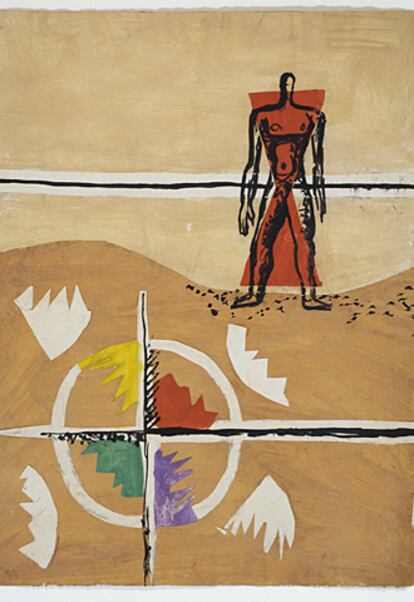"We are not skilled in faith". Religious change among the Komis
Modern religious processes in a Komi village can be interpreted by the dialogue between different local religious experts or even anarchy
"Our priest said that we are not supposed to believe in dreams. But sometimes in my fantasy flight I am inside the church over the congregation and I say 'look, look, you see how I fly!'" (68-year-old Komi lady)
My research involves studying new religious movements and the rebirth of the Russian Orthodox Church (ROC) in north-eastern European Russia. I am examining the Komis (a Finno-Ugric ethnic group) in the Ust-Kulom region of their Republic, about 1500 km north-east of Moscow, concentrating on local perspectives and attempting to map religious changes in the last 20 years.
The Komis' conversion from animistic religion to the Russian Orthodox faith, at the end of the 14th century, was orchestrated by Stephan Hrap (St Stephan of Perm). For centuries Orthodox Christianity became an integrated part of the worldview and everyday life of the Komis. Nowadays, the Orthodox religion is generally treated as the proper faith of the Komis.
In the post-Soviet period, two tendencies have resulted from the ROC's attempts to restore its former position in society. The first trend is related to the growing enthusiasm of churchgoers. The core of churchgoers is remarkably enthusiastic, having become devoted believers during the last 15 years, and this group contains mainly middle-aged and elderly Komi women who eagerly attend church ceremonies, Sunday school, and other related social events, proving that churchgoers' loyalty to their priest constitutes an important part of religious identity.
The second tendency is connected to marginalisation of the majority of the Orthodox population. A much larger group of the Komis represents a loose network of folk Orthodoxy with its members' faith manifested in more silent and hidden forms, where spiritual behaviour is not affected by the increase in public attention towards post-Soviet religious issues. Those practising the faith may be really skilled in traditional domestic religion and they preserved this through Soviet times when there were no churches or priests available in the region. These people themselves stress that they are not really 'believers' because they lack the knowledge about accurate faith, stating: 'the believers fasted but we lacked the skill so we did not fast!'
During the last 20 years, new religious movements and different non-Orthodox Christian confession have attempted to establish themselves among the Komis. At the same time, social pressure inside the Komi community exerts strong support for Russian Orthodox practices. Achievements of new religious groups are modest but their presence is important. In the region where I make my field studies, a small group of Evangelical Christians, led by an American missionary, is remarkably active. Actually, quite a few people have become real followers of Evangelism. Some Komi ladies go there just to chat with the other ladies:
They help us. Even a book was given for free. We arrive, and free food is provided. They offer tea and biscuits. Why not go there if they take us to the prayer house and back home by bus?
My aim is to analyse how the Komi people manage in the new religious situation where several spiritual options are present. At first, it seems that there is a sharp conflict between different religious agents. The local Russian Orthodox priest's public rhetoric (presented during church ceremonies and other public events) is rather aggressive towards 'sectarians'. His position correlates with the ROC's strategic principles and public discourse in the Russian media. The priest has an authority to criticize and correct spontaneous religious experiences and views of churchgoers. In common with the elderly lady whose dreams are related above, the believers respect the priest's viewpoint, although they may ignore it, anyway.
Simultaneously, the Orthodox priest coordinates people's spiritual activism with the Evangelical missionary. The priest admits, in private, that he is not able to get anybody from remote villages to his church and it is all right if people attend at least some kind of religious service.
The evangelical mission itself promotes a view that there is no basic difference between them and the Orthodox Christians. The Komis mostly distinguish Evangelical Christians by their unenthusiastic attitude towards icons. But one elderly lady expressed a hope to get 'an Evangelical icon' from the American missionary. She had already prepared a shelf for that purpose in the corner of her home. Local Komis discourse much about Evangelical Christians because their overall presence is a confusing issue, even a cause of overall spiritual disorder.
Religious viewpoints are rather confused even inside the circle of the Orthodox churchgoers. They can question a priest's spiritual authority and propose various heretical ideas. During a Sunday school meeting one old lady, despite the priest's desperate protest, enquired about the actual number of people in the Garden of Eden and criticised the vain unkindness of the God who directed a poor Pharaoh into a trap in the Red Sea. Another Komi lady reacted to the priest's reminder of the need to care about one's soul by proposing a solution to the resurrection problem through adopting reincarnation, seriously disappointing the priest with this unintentionally Buddhist statement.
In principal, local Komi people have multiple religious choices. But actually, 'the religious market' does not really exist in the Komi countryside (as in the majority of Russian regions). Alternative religious groups are marginal and the population generally considers them of low value.
During my field studies I have discovered that the post-Soviet spiritual clash among the rural Komis is not great. As we saw earlier, individual religious attitudes, such as the importance of dreams, do not always correspond to official religious discourse, represented by priests. But in general people respect the authority of ROC. Modern religious processes in a Komi village can be interpreted by the dialogue between different local religious experts or even anarchy (as sometimes people do not care too much about the correctness of their religious ideas). Contemporary rural Komi communities give us the example of creative social adaptation to new challenges of multireligiosity and growth of cultural diversity.
Art Leete. University of Tartu www.atomiumculture.eu

Tu suscripción se está usando en otro dispositivo
¿Quieres añadir otro usuario a tu suscripción?
Si continúas leyendo en este dispositivo, no se podrá leer en el otro.
FlechaTu suscripción se está usando en otro dispositivo y solo puedes acceder a EL PAÍS desde un dispositivo a la vez.
Si quieres compartir tu cuenta, cambia tu suscripción a la modalidad Premium, así podrás añadir otro usuario. Cada uno accederá con su propia cuenta de email, lo que os permitirá personalizar vuestra experiencia en EL PAÍS.
¿Tienes una suscripción de empresa? Accede aquí para contratar más cuentas.
En el caso de no saber quién está usando tu cuenta, te recomendamos cambiar tu contraseña aquí.
Si decides continuar compartiendo tu cuenta, este mensaje se mostrará en tu dispositivo y en el de la otra persona que está usando tu cuenta de forma indefinida, afectando a tu experiencia de lectura. Puedes consultar aquí los términos y condiciones de la suscripción digital.
Archivado En
Últimas noticias
Lo más visto
- Los grandes derrotados del Gordo de Navidad de Villamanín, 15 jóvenes de entre 18 y 25 años: “Hoy hemos perdido amigos”
- Acuerdo en Villamanín por el Gordo sin repartir: la comisión de fiestas cede más de dos millones por la paz del pueblo
- Junqueras avisa de que la recaudación del IRPF es “imprescindible” para negociar los presupuestos de Sánchez e Illa
- El alpinista Simone Moro sobrevive a un infarto a 5.000 metros y anuncia la creación de un servicio de rescate aéreo en el Karakoram de Pakistán
- Desaparecidos cuatro españoles de una misma familia de Valencia en un naufragio en Indonesia




























































